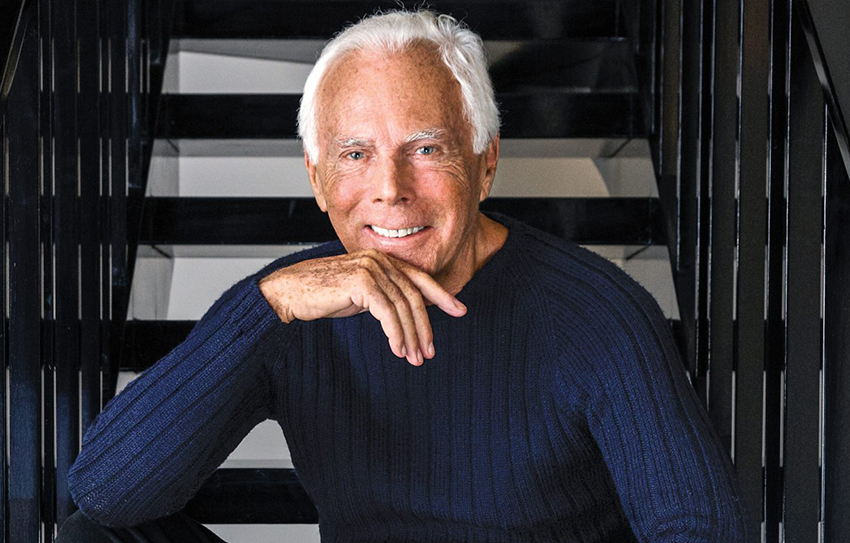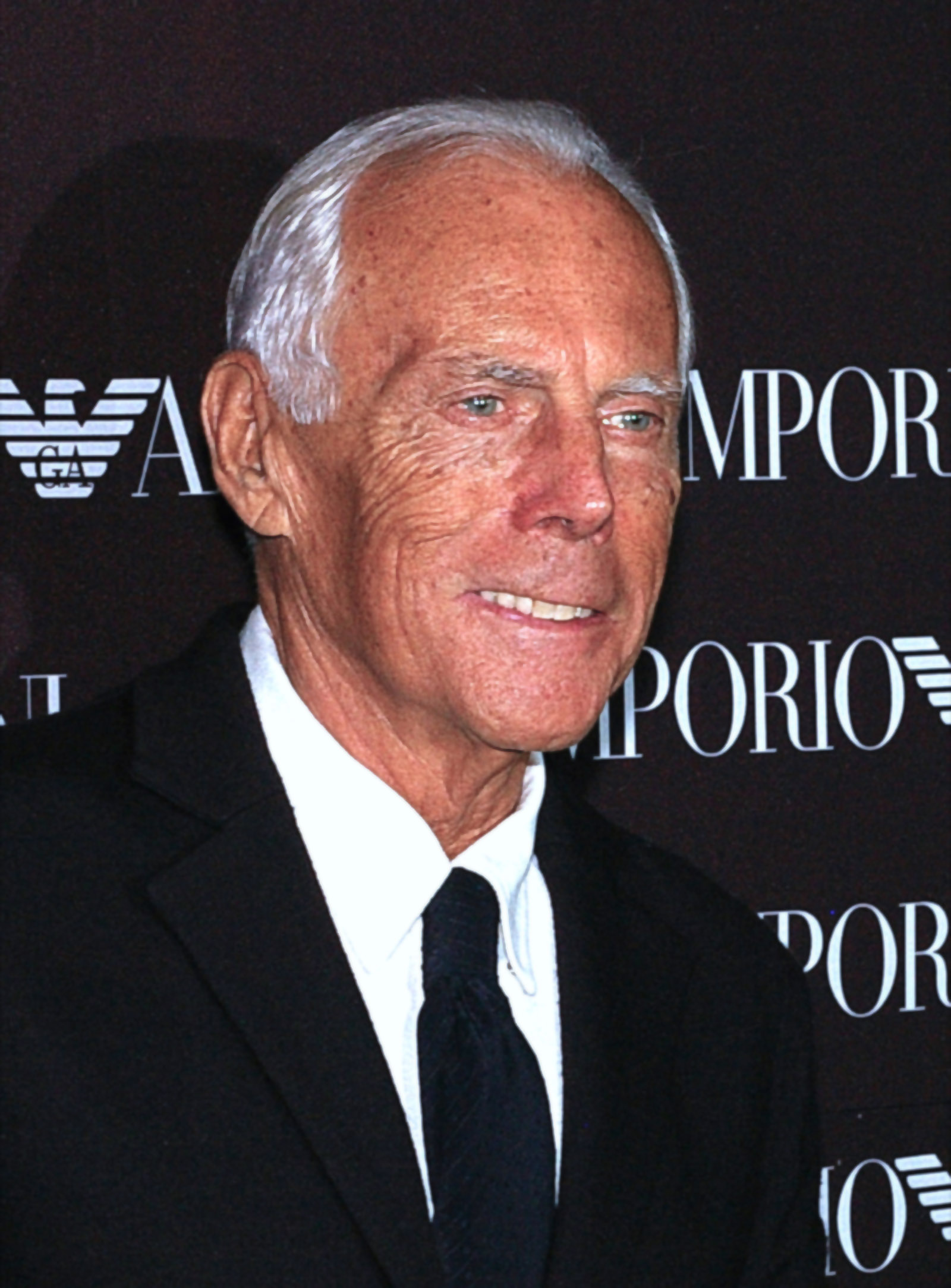Farewell to a Legend
In the early hours of a quiet September morning, the world of culture and design paused. News began to ripple through Milan — whispers at first, then headlines, then an overwhelming wave of tributes. A great figure, one whose influence had touched red carpets, city streets, and the very idea of elegance itself, had taken his final bow.
The announcement was measured, written with grace, yet heavy with meaning. It spoke of a man who worked without rest, whose vision shaped not only clothing but the way people carried themselves in public and in private. It spoke of someone who, even in his nineties, refused to step away from the workbench, from the sketches, from the meticulous details that made his creations so enduring.
“Peacefully,” the statement said, “surrounded by his loved ones.” These words, so simple, masked the magnitude of the moment. Peaceful for him, perhaps — but for the fashion world, the silence was deafening.
For nearly five decades, this man had stood as a beacon of independence in an industry often swayed by fleeting trends. He believed in clarity, in restraint, in elegance without noise. The empire he built reflected not just a commercial triumph but a philosophy, a way of living. His was a vision where confidence replaced ornament, where strength was found in subtlety, and where Milan itself became a capital of modern style.

Only after reading further, after digesting the measured phrases of the official statement, did the full weight settle in: it was Giorgio Armani who had passed away.
For millions, the name itself carried memories. A first suit bought for a special occasion. The signature clean lines of a jacket glimpsed on the silver screen. The quiet confidence of models stepping onto runways season after season, wearing clothes that looked effortless but were crafted with obsession. Armani was not simply a designer; he was an architect of identity.
In Milan, his beloved city, grief was palpable. The streets where his boutiques stood seemed muted. Locals recalled seeing him at events, fundraisers, and cultural openings. He was not distant, not hidden in ivory towers, but woven into the daily life of his country and his city. For them, this was not the loss of a remote celebrity but of a neighbor, a benefactor, a man who had shaped their home’s international image.
Tributes began pouring in — from Hollywood stars whose careers had been dressed in Armani’s elegance, from athletes who had worn his creations at Olympic ceremonies, from fellow designers who admitted that without his vision, their own work would not have been possible. Heads of state issued statements, remembering not only the brand but the man himself — a figure of discipline, dignity, and uncompromising taste.
Yet amid the cascade of global mourning, there was also an unmistakable tone of gratitude. Gratitude for a career that spanned half a century. Gratitude for a man who showed that fashion could be serious, architectural, and timeless. Gratitude for the independence he maintained, resisting buyouts and conglomerate pressures to keep his company his own.
The statement from his fashion house captured this spirit: “Over the years, Giorgio Armani has created a vision that has expanded from fashion to every aspect of life, anticipating the times with extraordinary clarity and precision. Tireless, he has worked until the last days, dedicating himself to the company, to the collections, to the different and always new projects in being and to becoming.”
Those who knew him best often described his insatiable curiosity — a mind that never rested, a gaze that was always observing. He noticed how people moved, how fabric fell, how the smallest stitch could shift the entire balance of a garment. His fascination was not with excess but with perfection. That was the standard he demanded of himself and of those around him, even in his final years.
As Milan mourned, the city also celebrated the man who had given it so much. His name was carved into its history: the museums he supported, the cultural projects he financed, the image of Milan he projected onto the world stage. For him, fashion was not an isolated pursuit but part of a broader dialogue with society — a dialogue that elevated his work from mere clothing to an enduring philosophy of life.
The shock of his death was softened by one truth: he had remained himself until the very end. In the words of his collaborators, he never surrendered to idleness. Even in illness, he remained engaged, overseeing projects, sketching, debating, envisioning what would come next. He left this world not as a man who had retired long ago but as a creator who still had more to give.
And so, as the tributes mounted and the grief spread, one thought lingered: the world had lost not just a designer, but a legend who reshaped the very definition of elegance.

The Man Behind the Brand
Long before his name became shorthand for sophistication, he was simply a boy from Piacenza, a small Italian town known more for its quiet charm than for glamour. Born in 1934, he grew up in the shadow of war, in a country that was rebuilding itself from ashes. Those early years left an impression: a deep respect for discipline, an understanding of scarcity, and an eye for beauty in simplicity. While others might have been drawn to extravagance, he learned that restraint often speaks louder than excess.
His path to fashion was not immediate. Medicine first captured his interest, and he enrolled at university with the hope of becoming a doctor. But lectures on anatomy and long hours in medical libraries could not hold him. Life had other plans. Leaving his studies behind, he worked briefly in the military before finding himself in Milan, the city that would become both his canvas and his stage. There, he began as a humble window dresser at La Rinascente, one of Italy’s most prestigious department stores. It was here, arranging mannequins and studying the flow of fabrics under the lights, that he discovered not just a job but a calling.
The transition from dressing store windows to dressing the world was gradual but determined. In the 1960s, he collaborated with fashion house Nino Cerruti, designing menswear that caught attention for its clean lines and modern sensibility. This was a crucial period — Armani learned the mechanics of tailoring, but he also recognized something missing in the industry: a quiet kind of power, one that didn’t rely on glitter or flamboyance.
By 1975, with just $10,000 in capital and a modest office, he and his partner Sergio Galeotti launched a brand that would redefine modern fashion. What began as a small operation quickly became a global phenomenon. Armani understood something few others did: clothing could project not only style but identity. His jackets softened the rigidity of traditional tailoring, giving men and women garments that were structured yet comfortable, authoritative yet approachable.
Hollywood noticed. By the 1980s, Armani’s name was practically stitched into the fabric of cinema. Richard Gere’s wardrobe in American Gigolo turned his suits into objects of desire across the world. From that point on, red carpets gleamed with his designs — stars trusted him not only for glamour but for confidence. He was not selling costumes; he was crafting personas. To wear Armani was to declare independence, to project strength without ostentation.
Still, his empire was never built only on celebrity endorsement. Armani expanded with discipline and vision. From clothing, he moved to accessories, cosmetics, fragrances, and eventually hotels and even furniture. Each extension of the brand carried the same DNA: understated elegance. Unlike many of his peers who sold their names to corporate conglomerates, he insisted on keeping control. Independence, both personal and professional, was his hallmark. He often said that Armani was not just a label but a reflection of himself — his values, his philosophy, his identity.
What made his designs remarkable was their timelessness. In an industry obsessed with novelty, Armani pursued permanence. He believed true style transcends seasons. A jacket designed in 1985 could be worn decades later without losing relevance. This consistency attracted generations of clients, from first-time buyers saving up for a single blazer to billionaires ordering entire wardrobes.
Behind the polished runway shows, however, stood a man of remarkable discipline. Armani was known to rise early, keep to strict routines, and work tirelessly well into the night. He was famously detail-oriented, reviewing sketches, fabrics, and even store layouts personally. This intensity sometimes intimidated those around him, but it also inspired loyalty. Employees and collaborators referred to him with reverence, simply as “Mr. Armani.”
As his empire grew, so did his influence. By the 2000s, his brand was valued in the billions, with boutiques spanning every continent. Yet, despite this global reach, he remained deeply tied to Milan. He invested in cultural institutions, supported local causes, and insisted that his headquarters remain in the city that had given him so much. Milan was not just his business base; it was his muse.
Looking back on his career, Armani once reflected: “My goal in the beginning was to assert my vision and to dress people. In some ways it’s still the same idea today.” That simplicity — to dress people, not just models or celebrities — defined his genius. He never lost touch with the everyday man and woman who wanted clothes that empowered them, not overwhelmed them.
By the time his health began to decline, Armani had already achieved what most designers could only dream of: creating a brand worth an estimated $10 billion, a global empire built not on trends but on trust. More than that, he had built a philosophy that outlived seasonal collections — a belief in dignity, discipline, and independence.
His story was not just one of fashion but of resilience. From a boy in postwar Piacenza to the head of one of the world’s most enduring fashion houses, his journey embodied the very idea of self-reinvention. And while his passing left a void, the empire he built ensured that his vision would not disappear.
Legacy Beyond Fashion
When people think of Giorgio Armani, they often picture the sharply tailored suits, the clean lines of his evening gowns, or the minimalist palette that became his signature. Yet his influence stretched far beyond the boundaries of fashion shows and boutiques. Armani was not only a designer of clothing; he was a designer of life.
Over the decades, his brand expanded into fields that seemed, at first, far removed from fashion. Hotels, restaurants, home décor, even sports uniforms carried his touch. Each of these ventures bore the same unmistakable stamp: elegance in simplicity. Armani understood that style was not limited to the body — it was a philosophy that could shape environments, experiences, and even communities.
One of the most striking examples of this vision was the Armani Hotels. In Milan and Dubai, guests walked into spaces that mirrored the designer’s philosophy — muted tones, clean architecture, comfort without excess. The rooms were extensions of his runways, an invitation to live inside the Armani world. To sleep on Armani sheets, to eat in an Armani restaurant, to shop in an Armani boutique beneath the same roof — this was not just branding; it was lifestyle curation.
Armani’s reach extended into the world of sports as well. He famously designed uniforms for the Italian Olympic team, ensuring that athletes carried not only national pride but also a sense of dignity and style onto the global stage. To Armani, clothing was always about identity, and in representing Italy, he saw an opportunity to merge patriotism with aesthetics. The athletes who wore his designs became ambassadors of his vision, proof that elegance could coexist with strength and competition.
Philanthropy, too, marked his career. While he avoided the spotlight in his charitable endeavors, Armani consistently supported medical research, disaster relief, and cultural institutions. His devotion to Milan was particularly visible — funding restorations, supporting museums, and contributing to the city’s transformation into one of the world’s foremost capitals of design and culture. In his eyes, giving back was not a matter of publicity but of responsibility.
Perhaps what set him apart most was his refusal to surrender independence. In an era where major fashion houses became subsidiaries of global luxury conglomerates, Armani stood alone. He guarded his company fiercely, determined that it would remain a reflection of his values rather than a product of corporate strategy. This decision, while financially demanding, allowed him to preserve authenticity. Even in his final years, he remained involved in decisions that other designers might have delegated. He was not content to be a figurehead — he was the engine, as his employees affectionately called him.
With his passing, questions inevitably arise about the future of his empire. The Armani Group, valued at nearly $10 billion, faces the challenge of carrying on without the guiding hand of its founder. Yet those who worked beside him insist that his values — discipline, restraint, independence — are deeply embedded in the company’s culture. Armani himself often prepared for this moment, insisting that the brand was built not on his personality alone but on a philosophy strong enough to endure.
What, then, is Giorgio Armani’s legacy? It is not only the jackets that softened the edges of traditional tailoring, or the gowns that glided down Hollywood red carpets. His legacy is the conviction that fashion is not about noise but about clarity. He showed the world that elegance does not scream; it whispers. He proved that true style is not bound by season or trend but by permanence.
He also left behind a blueprint for future generations of designers: resist the urge to compromise your vision, trust in restraint, and understand that the greatest luxury is independence. In an age when consumerism often celebrates excess, Armani reminded us that simplicity has power.
As Milan prepares to honor him with memorials and retrospectives, the city feels his absence like the loss of a heartbeat. He was not merely a resident but a symbol of its identity. Through his designs, investments, and cultural contributions, he elevated Milan into a global fashion capital. To walk its streets now is to sense his presence in every window, every gallery, every museum wing that bears traces of his support.
For the world, Armani remains a figure of timeless relevance. His name will continue to live on through the suits worn by executives, the gowns chosen by actresses, the furniture that fills minimalist homes, the hotels that host international travelers. His brand, like his philosophy, was never about temporary fame. It was about permanence.
In the end, Giorgio Armani’s life was less about fabric and more about identity. He clothed not just bodies but generations, giving people a way to present themselves with confidence and dignity. His passing is the closing of a chapter, but the story he wrote continues.
And perhaps that is the most fitting tribute: that fifty years from now, long after the headlines of his death have faded, someone will put on an Armani jacket, look in the mirror, and feel the quiet power of elegance.

Adrian Hawthorne is a celebrated author and dedicated archivist who finds inspiration in the hidden stories of the past. Educated at Oxford, he now works at the National Archives, where preserving history fuels his evocative writing. Balancing archival precision with creative storytelling, Adrian founded the Hawthorne Institute of Literary Arts to mentor emerging writers and honor the timeless art of narrative.
